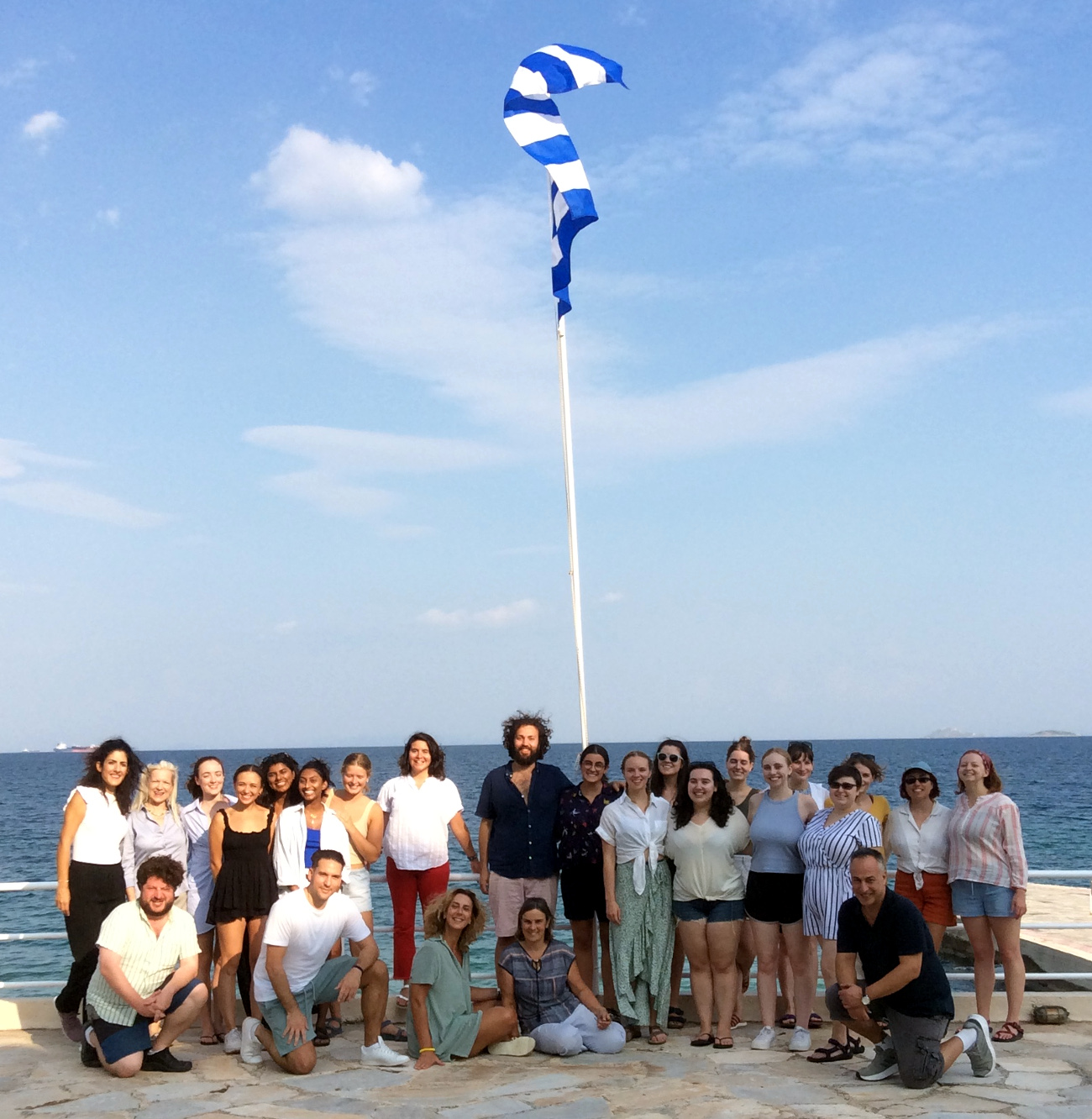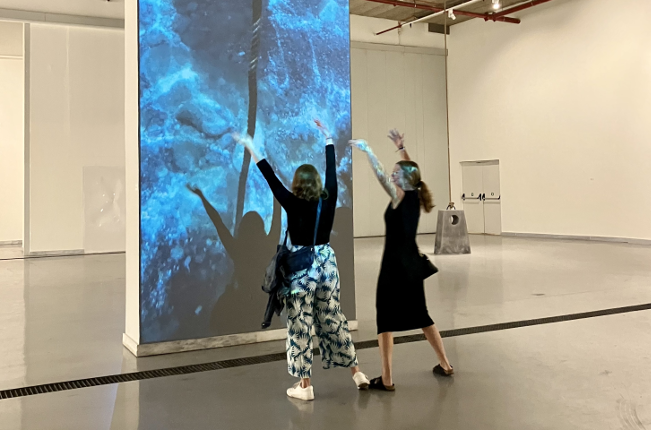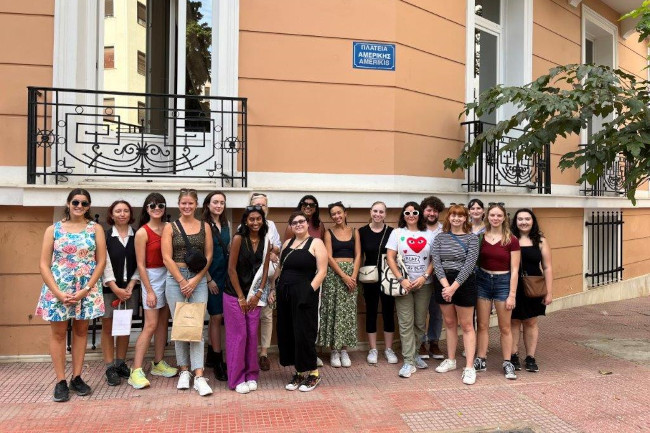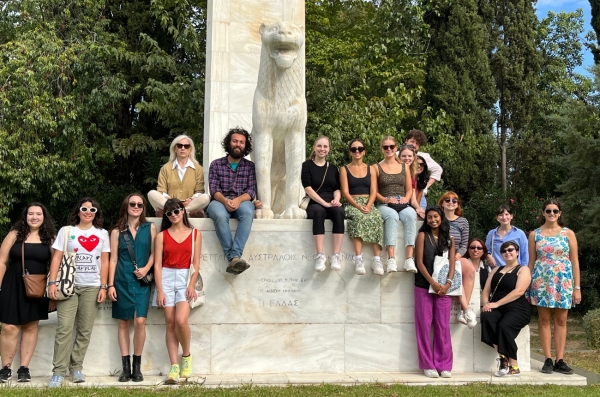Photo: The walking group explores the neighborhood of Kypseli at Pedion tou Areos park, Statue of Athena.
Grantees enrich their learning by engaging in a series of enlightening experiences focused on the history and culture of Greece. This journey unfolds through a blend of insightful lectures, guided museum tours, and educational strolls.
The arrival orientation, tailored for the new U.S. grantee cohort, is a comprehensive introduction to Fulbright logistics and cultural insights. It culminates in a convivial welcome reception at the American School of Classical Studies at Athens – Gennadius Library Gardens, where the new cohort connects with recently returned Greek grantees, the Fulbright Board, donors, friends. This year, we were honored by the attendance of U.S. Ambassador to Greece George J. Tsunis and Greek Minister of Education Kyriakos Pierrakakis. The orientation commenced with a delightful day-trip to Kalamaki Beach Resort in Corinth. There, students and teaching fellows savored the sea breeze, while also trying their hand at traditional Greek dances and working as a team.
 Photo: one-day-trip to Kalamaki Beach Resort in Corinth.
Photo: one-day-trip to Kalamaki Beach Resort in Corinth.
As autumn progressed, invitations abounded: from a screening of From Both Sides of the Aegean 1922–1924: Expulsion and Exchange of Populations in 1923, a documentary by Fulbright alumna Maria Iliou, at the Athens Concert Hall – Megaron Mousikis to an exhibition tour and discussion of Free from What by Fulbright alumna Maria Papanikolaou at annexM to the annual Athens Cultural Walk. In 2023, the walking expedition ventured through the captivating neighborhood of Kypseli with its intriguing blend of long-time residents of Athens, immigrants, and young creatives. Highlights included a visit to the historical Pedion tou Areos park, adorned with nods to the Greek Revolution, and a coffee break on Fokionos Negri Street, followed by explorations of Meteoritis bookstore and the Kypseli Central Market.
The turn of the year heralded the gradual arrival of U.S. Fulbright Scholars and Distinguished Teachers, the “soft” orientation introduced them to local realities, fostered connections with Greek counterparts, and included educational and cultural outings.
In mid-February, a reunion brought together all U.S. grantees for a captivating guided tour of the exhibition In the Name of Humanity: American Relief Aid in Greece, 1918–1929, led by curators and Fulbright alumni Dr. Maria Georgopoulou and Dr. Natalia Vogeikoff-Brogan at the American School of Classical Studies at Athens. The day concluded with the traditional Vasilopita cutting.
Spring festivities unfolded at the welcoming abode of the Elliniki Etairia in Plaka, a shining example of a civil society with longstanding collaborations with local committees throughout Greece. Lydia Carras, Founder & Vice President, greeted us and offered insights into Elliniki Etairia’s impactful work nationwide.
The program also featured a thought-provoking presentation and discussion with Constantinos Cartalis, Professor of Environmental and Climate Science at the National and Kapodistrian University of Athens, on Safeguarding Cultural Heritage from Climate Change — Challenges and Prospects at the National and International Scale.
A Fulbright grant to Greece represents more than just financial assistance; it offers recipients a truly transformative cultural and academic journey. From pre-departure support to ongoing assistance while in Greece, Fulbright ensures grantees are well-equipped for their experience. Beyond the scholarship itself, receiving a Fulbright grant opens doors to a multitude of professional, educational, and networking opportunities, both locally and globally. Fulbright Greece actively engages in various activities to promote the Foundation’s interests and programs, including organizing public lectures, training sessions, workshops, and other outreach events. Encouraging ongoing communication and involvement, Fulbright Greece encourages all grantees to maintain connections and actively participate in the community.
U.S. Fulbright Fellow to Greece Anagha Ramakrishnan reports on some of the events:
Free from What, Maria Papanikolaou
Eight anchors are strategically placed across an exhibition space. The ropes were supposed to be connected to the ceiling, but instead, the scene captures the exact moment they have been cut. Fulbright Alumna, Maria Papanikolaou depicts a scene of how stability and security can also become debilitating and imprisoning. Suddenly, we felt trapped in a moment in time. Freedom is imminent, but the exhibition left me wondering if freedom was ever possible in the first place? Upon walking in, the exhibition felt barren yet filled with tension. We tried to figure out what we were seeing. A drilled line on one wall. Light installations depicting an escape. Ripped paper. Anchors obstructing our path.
Papanikolaou offered us a peek into her studio space where we saw her process through an audio tour. This rare opportunity to sit with the artist and see how she made her work felt like we were almost infringing on her space. All of us gathered on a bench and a lively discussion ensued.
One of the Fulbright ETAs, Sarah Mayo, captured the feeling perfectly. She quoted the poem Pledge by Dana Levin:
My project had been getting T. to build me a free standing door in a frame, a door you could put anywhere, that could open and close.
[…] and a portal opened through space, powered by wish and imagination—while Time beat time on the skin of the world.
Stuck in a moment of time, we entered a portal of possibilities. The viewer is left to decide what happens next. For the next hour, we discussed how safety can be claustrophobic, how the artist can be a provocateur, and how the viewer can be a part of the exhibition itself.
 Photo: U.S. Fulbright Fellows at the Free from What exhibition, annexM, Athens Concert Hall
Photo: U.S. Fulbright Fellows at the Free from What exhibition, annexM, Athens Concert Hall
Exploring the beehive
Kypseli, which means “beehive” in Greek, represents an ever-changing Athens. Once a thriving, middle- to upper-class neighborhood that changed its face after World War II, it now represents a multicultural hub. The beehive still buzzes, yet its tone has changed. Sixteen Fulbrighters tasted the sweet honey the town had to offer.
We started our day at Victoria Square, walking toward the park and stopping at Green Park. This symbolic all-day cafe serves as a mirror of Kypseli and was once a bustling entertainment venue representing the heartbeat of Athens. It first opened its doors in the 1930s and closed in 2008, before reopening in 2022. Since its revival, it has welcomed a new audience. The cafe is still reminiscent of what I imagine Kypseli once was, but now reflects a mosaic of a growing, modern community. We then walked through Pedion tou Areos or the Field of Ares, where we saw the stories of old war heroes commemorated throughout the park. We continued our trek onwards and passed through Agiou Georgiou Square, Fokionos Negri Street, and made our way to the Kypseli Central Market. While polykatoikies (apartment blocks) fill the streets, in every corner we turned, an architectural landmark stood between them, showing the stark difference between what Athens once was and what it is now.
 Photo: The walking group explores the neighborhood of Kypseli at Amerikis Square
Photo: The walking group explores the neighborhood of Kypseli at Amerikis Square

